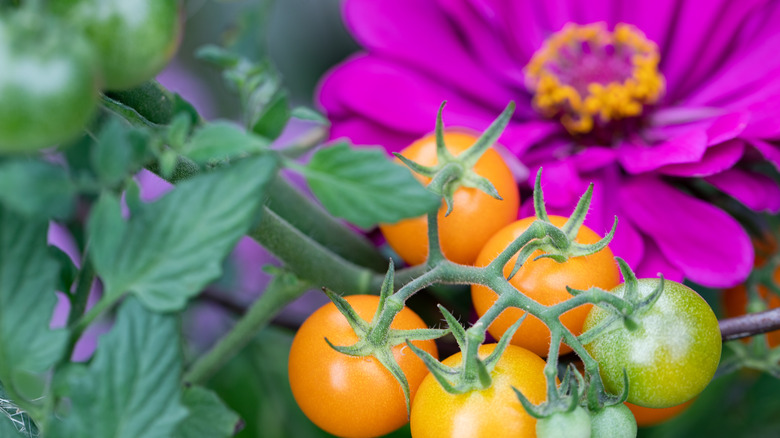Scores of homeowners foray into the world of gardening by growing tomatoes. Although seeing red gems with green foliage is pleasing enough, adding a rainbow of color through zinnias (Zinnia spp.) doesn’t hurt. Available in hues from light pastels to multicolored variations (except blues), zinnias have been ruling hearts with their saucer-shaped blooms that sometimes resemble daisies, dahlias, or beehives. They’re the only flowers to have an opera titled after them: “Zinnias: The Life of Clementine Hunter,” as Hunter loved painting them. Most varieties stay within 4 feet of height, supporting coarse, hairless, linear green foliage.
Visual aspects aside, there are many reasons why zinnias complement tomatoes. These nectar-producing beauties attract pollinators, including songbirds, bees, butterflies, and hummingbirds, improving the tomato crop. Additionally, by attracting beneficial insects, they also take care of aphids, caterpillars, and other pests ogling tomatoes for a sweet meal. Plus, even the worst gardeners can handle them, since they’re easy to grow and maintain. And, since both tomatoes and zinnias have similar care requirements, planting them near one another will make growing both plants a breeze. Moreover, they’re often disliked by rabbits and deer, so planting them around your Romas may leave you enough fruit to whip up a homemade tomato sauce.
Zinnias attract thirsty pollinators

Though tomatoes are self-pollinators with a colossal 96% success rate, they still appreciate additional help, especially when growing in areas with little wind. Tomatoes may support both male and female organs, but for them to fertilize, the pollen must be released, and a little shake helps with that. While you can take on the arduous job, pollinators can do it for free, provided you bribe them with zinnias. These Aster family members entice butterflies like monarchs, swallowtails, and American ladies to your tomato garden with their sweet-sap-producing blooms that last until the first frost. Bees, especially bumble bees and honey bees, can’t resist them and aid pollination. This improves fruit production and the subsequent crop yield (although songbirds may gobble down some seeds).
To get the best results, plant taller varieties with broader, flat-surfaced blooms, such as Cut and Come Again, Benary’s Giant, California Giant, Tall State Fair, and Lilliput, as they offer sufficient perch room. University of Kentucky research from 2009 shows that most butterfly species prefer Lilliput over other sample zinnia cultivars. But if you’re looking for shorter bedding plants to complement your indeterminate tomatoes, check out the dwarf profusion range — most cultivars stay between 12 and 15 inches. However, some hybrid cultivars might have lost their nectar-making capabilities, so read the seed packet carefully before growing zinnias.
Planting zinnias around tomatoes

Upping your tomatoes’ game is a breeze with zinnias because they demand similar growth conditions. Both plants enjoy sunbathing for over six hours daily — any less, and they might contract leaf spot diseases. Don’t forget to prune tomatoes, as they may overshadow their tinier companions. Since zinnias grow in soils with pH levels between 5.5 and 7.5, they adjust easily to the more acidic requirements of tomatoes. The substrate must drain well or be amended with compost to improve permeability. Although these low-maintenance splendors withstand drought stress, you should irrigate them regularly — preferably in the mornings and at the plant’s base — to avoid having them compete and starve your tomatoes of water. This should additionally take care of powdery mildew, the bane of most zinnia plants.
Although zinnias aren’t usually pest-prone, they can become meals for aphids and whiteflies in hot and dry conditions. Luckily, they, especially the Lilliput cultivars, also lure in useful bugs like parasitic mini wasps and hoverflies that prevent these sap-sucking pests from spreading mosaic viruses in tomatoes. These beneficial insects also prey on caterpillars that damage tomato seedlings. To enjoy the benefits, plant a few rows of zinnias adjacent to the tomatoes or interplant them. Deadhead zinnias to prolong their flowering season (and their benefits).



